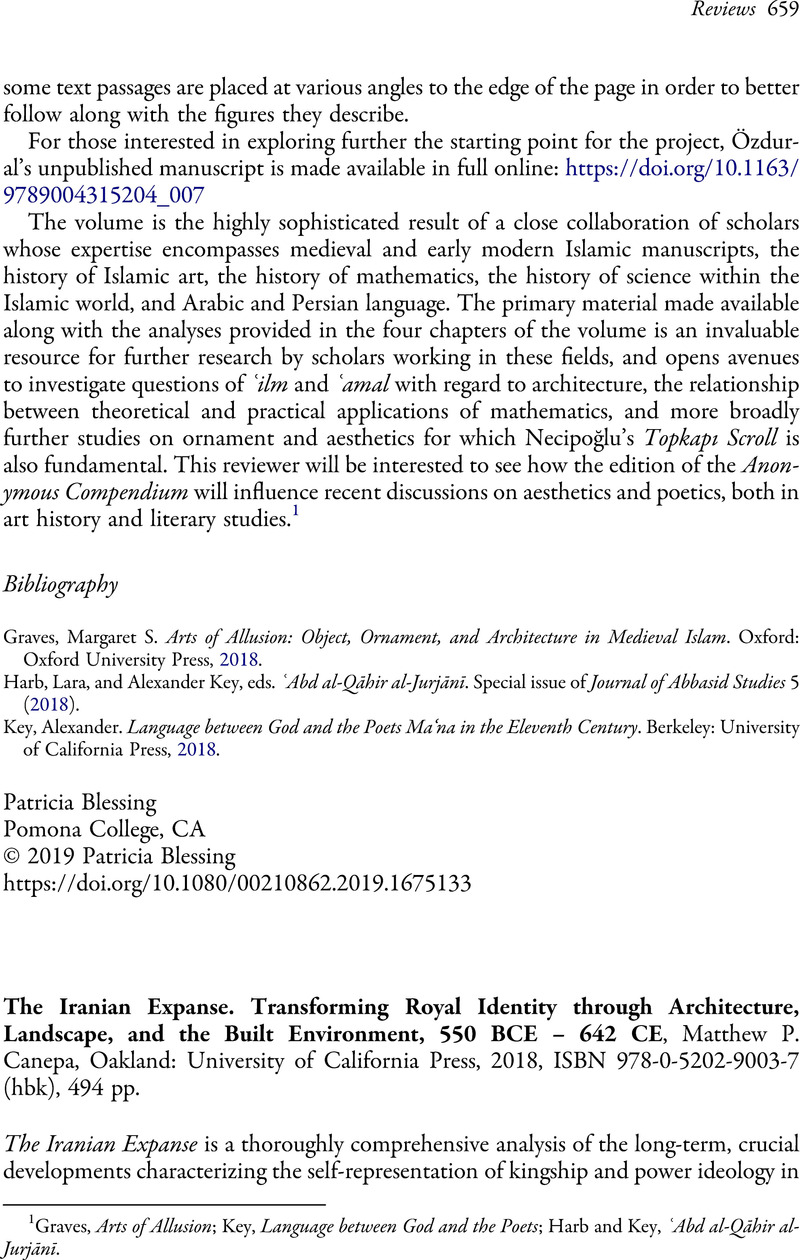No CrossRef data available.
Article contents
The Iranian Expanse. Transforming Royal Identity through Architecture, Landscape, and the Built Environment, 550 BCE – 642 CE, Matthew P. Canepa, Oakland: University of California Press, 2018, ISBN 978-0-5202-9003-7 (hbk), 494 pp.
Published online by Cambridge University Press: 01 January 2022
Abstract
An abstract is not available for this content so a preview has been provided. Please use the Get access link above for information on how to access this content.

- Type
- Reviews
- Information
- Copyright
- Copyright © Association For Iranian Studies, Inc 2021
References
Boyce, M., and Grenet, F., A History of Zoroastrianism. Volume Three: Zoroastrianism under Macedonian and Roman Rule. Leiden: Brill, 1991.CrossRefGoogle Scholar
Callieri, P. “Achaemenid ‘Ritual Architecture’ vs. ‘Religious Architecture’: Reflections on the Elusive Archaeological Evidence of the Religion of the Achaemenids.” in Persian Religion in the Achaemenid Period / La religion perse à l’époque achéménide, ed. Henkelman, W.F.M. and Redard, C., 385–416. Wiesbaden: Otto Harrassowitz, 2017.CrossRefGoogle Scholar
Colliva, L., and Terribili, G., “A Forgotten Sasanian Sculpture: The Narseh’s Fifth Bust from the Monument of Paikuli.” Vicino Oriente 21 (2017): 167–195.CrossRefGoogle Scholar
Garrison, M.B. The Ritual Landscape at Persepolis: Glyptic Imagery from the Persepolis Fortification and Treasury Archives. Chicago, IL: Oriental Institute of the University of Chicago, 2017.Google Scholar
Henkelman, W.F.M. The Other Gods Who Are: Studies in Elamite-Iranian Acculturation Based on the Persepolis Fortification (Achaemenid History 14). Leiden: Nederlands Instituut Voor Het Nabije Oosten, 2008.Google Scholar
Henkelman, W.F.M. “Humban & Auramazdā: Royal Gods in a Persian Landscape.” In Persian Religion in the Achaemenid Period / La religion perse à l’époque achéménide, ed. Henkelman, W.F.M. and Redard, C., 273–346. Wiesbaden: Otto Harrassowitz, 2017.CrossRefGoogle Scholar
Khounani, A., and Mohammadifar, Y., “Two Parthian Period Rock Reliefs from Iraqi Kurdistan.” Parthica 20 (2018): 137–146.Google Scholar
Lincoln, B. Happiness for Mankind: Achaemenian Religion and the Imperial Project (Acta Iranica 53). Leuven: Peeters Publishers, 2012.Google Scholar
Romano, S. “Arte del medioevo romano: la continuità e il cambiamento.” In Roma medievale, ed. Vauchez, A., 267–289. Roma: Editori Laterza, 2001.Google Scholar
Von Gall, H. “Zu den ‘medischen’ Felsgräbern in Nordwestiran und Iraqi Kurdistan.” Archäologischer Anzeiger 81 (1966): 19–43.Google Scholar
Von Gall, H. “Des Felsgrab von Qizqapan. Ein Denkmal aus dem Umfeld der achämenischen Königsstraße.” Baghdader Mitteilungen 19 (1988): 557–582.Google Scholar


